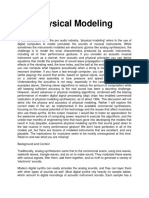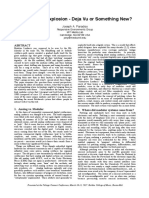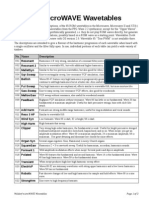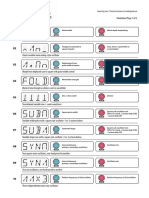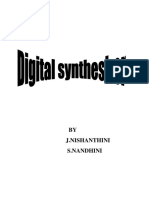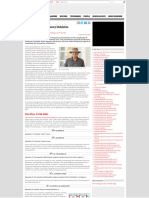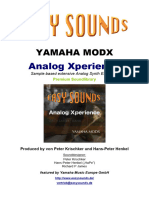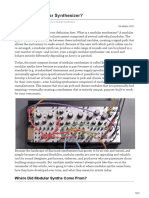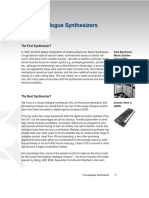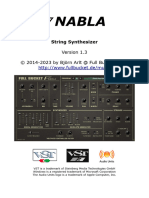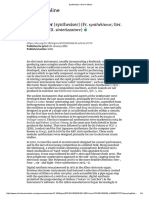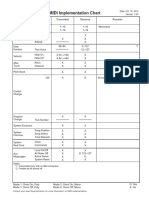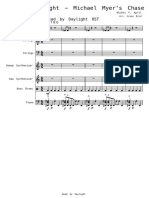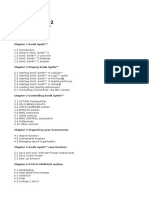Class 6: digital synths
Yamaha released the DX-7, a 16-voice polyphonic digital synth with 32 internal memories and a ROM/RAM
cartridge slot; overnight, the industry was seemingly turned upside down -- the supply simply could
not keep up with the demand, and for the next several years Yamaha thoroughly dominated the synth
market.
Wavetable synthesis is fundamentally based on periodic reproduction of an arbitrary, single-cycle waveform.
[3] The distinction to other synthesis methods employing single-cycle waveforms is twofold: 1) multiple
single-cycle waveforms are used while 2) one or several wave modulators control the change between those
multiple waveforms or mixtures thereof.
In wavetable synthesis multiple such single-cycle wavetable oscillators are in use, originally[4] as a table of 64
waveforms with 128 samples each, while the term "wavetable" for this arrangement appeared later in the PPG
literature for the PPG Wave[5].
The particular sound associated with wavetable synthesis is unique, since only perfect harmonics are produced.
The technique was first developed by Wolfgang Palm of PPG in the late 1970s [1] and published in 1979[2], and
has since been used as the primary synthesis method in synthesizers built by PPG and Waldorf Music and as an
auxiliary synthesis method by Sequential Circuits, Ensoniq, Korg, Access and Dave Smith Instruments among
others.
During playback, the sound produced can be harmonically changed by moving to another point in the
wavetable, usually under the control of an envelope generator or low frequency oscillator but frequently by any
number of modulators (matrix modulation). Doing this modifies the harmonic content of the output wave in real
time, producing sounds that can imitate acoustic instruments or be totally abstract, which is where this method
of sound creation excels. The technique is especially useful for evolving Synth pads, where the sound changes
slowly over time.
SEQUENTIAL CIRCUITS PROPHET VS
The Prophet VS uses Vector Synthesis as its revolutionary new means of sound creation. It uses a total of four
oscillators per voice with 127 waveforms (32 user) and dynamic waveform crossfading via the joystick.
This was Sequential's first digital synth, and it was also their final synth unfortunately. But after Sequential was
gone, Vector Synthesis technology went into the popular Korg Wavestation and Yamaha's SY-22 and TG-
33. The Prophet VS is a 61-note, five-octave, 16-note polyphonic, programmable synthesizer with a velocity-
sensitive keyboard and a MIDI specification that's especially good for a synth of this vintage. All the
parameters of Vector synthesis are assigned, recognised and transmitted — a MIDI sophistication that befits
a keyboard from a company that was so instrumental in the establishment of MIDI, and that made the first-
ever MIDI synth, 1982's Prophet 600. There's also a unique on-board arpeggiator that allows 'overdub'
arpeggiation and is thus capable of producing very sophisticated patterns. The VS has 100 factory sounds
(stored in 10 banks), made up from multiples of waveforms that could be effected with a built-in stereo
chorus unit, and even panned in real time.
The 128 waveform possibilities that the VS offered consisted of 96 factory-preset waves, plus a further 32 user-
definable waveshape locations. The real beauty of the synthesizer was that, for the first time, you could
create totally new, previously unheard sounds almost instantly. It was as simple as choosing four
waveforms, assigning them to the four oscillators (vector points), and then moving the VS's trademark
joystick around freely until you heard something pleasing. Movements, or 'vectors' could then be saved, and
the sound played back. It was even possible to apply the recorded vector path to another sound altogether
and see what happened.
�It all seems straightforward, and theoretically it is. The clever bit on the part of the synthesizer is calculating
smooth transitions between the four oscillators and their associated waveforms as the user moves the
joystick into positions between the four vector points. Though this form of synthesis had been known about
in theory for some time, it was only the advent of sufficiently powerful digital processors that allowed it to
become a reality. The sophisticated overlay algorithms determining the percentages of waveform
characteristics that would be heard at any point still had to be calculated, of course. And it was this, the
smooth transition between oscillator characteristics, that Dave Smith and his design team at Sequential were
so pleased about when they finally got it to work.
DEMO – ES2 (wavetable synthesizer)





